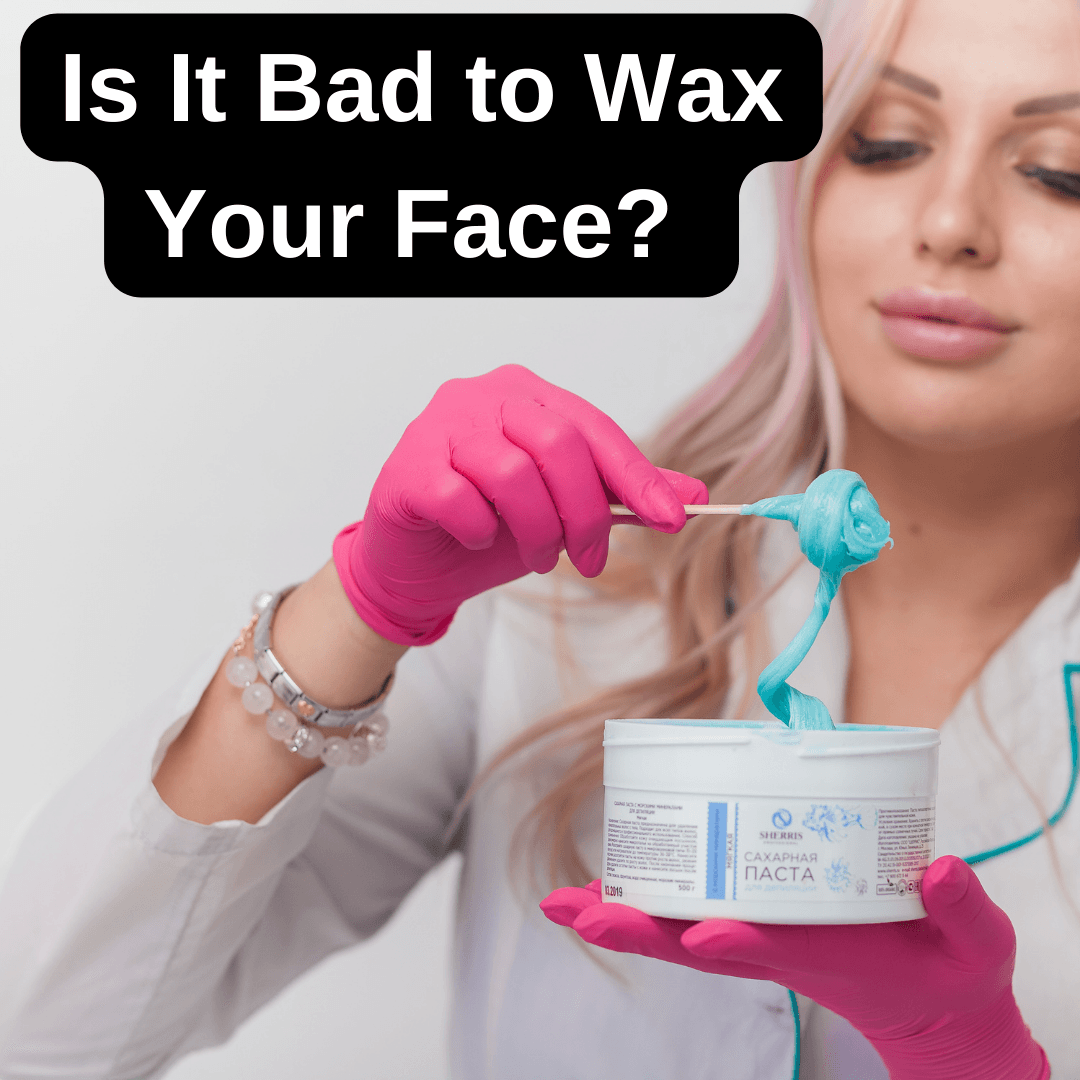Waxing is a common facial hair removal method, but is it bad for your skin? Many people wonder if waxing damages the skin, increases hair growth, or causes acne. In this ultimate guide, we’ll break down the advantages and disadvantages of face waxing, expert recommendations, and how to avoid common mistakes.
Face waxing is not inherently bad, but it requires proper technique and aftercare to avoid irritation. It offers long-lasting smoothness, reduces regrowth over time, and exfoliates the skin, but it may cause temporary redness, sensitivity, or breakouts in some individuals.
Face Waxing is GOOD if:
- You want long-lasting smoothness without daily maintenance.
- You follow proper aftercare to prevent irritation.
- Your skin tolerates waxing without excessive redness or breakouts.
Face Waxing is BAD if:
- You have extremely sensitive or acne-prone skin.
- You frequently experience ingrown hairs or irritation.
- You don’t follow aftercare, leading to breakouts or skin damage.
If done correctly and with the right aftercare, face waxing is an effective and safe method for hair removal. However, if you experience frequent irritation, consider alternatives like laser hair removal, dermaplaning, or threading.
Is It Bad to Wax Your Face?
Waxing your face is generally safe if done correctly. However, it can lead to irritation, redness, and even breakouts if not done properly. Factors like skin type, frequency, and technique play a significant role in determining whether face waxing is beneficial or harmful.
Pros of Face Waxing
- Removes Hair from the Root: Provides long-lasting smoothness (up to 4 weeks).
- Exfoliates the Skin: Removes dead skin cells, making skin appear brighter.
- Less Regrowth Over Time: Regular waxing may lead to finer, sparser hair regrowth.
- Suitable for Sensitive Areas: Unlike shaving, waxing avoids blunt edges and stubble.
Cons of Face Waxing
- Skin Irritation: Can cause redness, especially for sensitive skin.
- Risk of Ingrown Hairs: If not done properly, hairs may grow under the skin.
- Potential for Burns: Hot wax can cause burns if applied too hot.
- Temporary Redness & Bumps: Some individuals may experience irritation immediately after waxing.
However, if you experience frequent irritation, consider alternatives like laser hair removal, dermaplaning, or threading. Laser hair removal can be a long-term alternative for those who find waxing too harsh on their skin.
If you’re debating between waxing and epilating facial hair, this comparison covers the key differences and safety tips.
How to Wax Without Skin Damage?
Repeated waxing can weaken the skin barrier, especially for those with sensitive skin. If done incorrectly, it may lead to:
- Skin irritation and redness
- Minor burns from hot wax
- Post-wax breakouts due to clogged pores
- Increased sensitivity in thin-skinned areas like the upper lip
How to Prevent Damage:
To minimize skin damage and ensure a safe waxing experience, follow these key steps. The table below summarizes the best practices for temperature control, skin preparation, and post-wax care, followed by a detailed explanation of each step.
Table: Essential Face Waxing Precautions
| Prevention Step | Why It Matters | How to Do It Properly |
| Check Wax Temperature | Prevents burns and irritation | Test wax on wrist before applying to the face |
| Avoid Damaged Skin | Waxing over cuts, acne, or sensitive areas worsens irritation | Skip waxing if skin is irritated, broken, or healing |
| Exfoliate Before Waxing | Removes dead skin, reducing risk of ingrown hairs | Use a gentle exfoliant 24 hours before waxing |
| Use the Right Wax | Soft wax for fine hair, hard wax for thick/coarse hair | Choose wax type based on your hair and skin sensitivity |
| Apply Wax in the Right Direction | Reduces pulling and skin trauma | Spread wax in the direction of hair growth |
| Pull Wax Off Correctly | Prevents unnecessary pain and ingrown hairs | Pull in the opposite direction of hair growth in one quick motion |
| Soothe Skin Post-Wax | Helps calm redness, swelling, and irritation | Apply aloe vera, witch hazel, or cold compress |
| Moisturize Properly | Restores skin barrier and prevents dryness | Use fragrance-free moisturizer 6–12 hours after waxing |
| Avoid Makeup and Harsh Skincare | Prevents clogged pores and post-wax breakouts | Skip heavy creams, acids, or retinoids for 24 hours |
| Protect Skin from the Sun | Prevents post-wax hyperpigmentation | Wear SPF 30+ sunscreen daily after waxing |
1. Check Wax Temperature Before Application
Applying wax that is too hot can cause burns, blisters, or irritation. Always test the temperature by placing a small amount on your wrist or inner forearm before applying it to your face. The wax should feel warm, not hot.
2. Avoid Waxing Over Damaged Skin
If you have cuts, acne, sunburn, or irritation, avoid waxing that area as it can worsen inflammation, cause bleeding, or lead to infections. Instead, wait until your skin fully heals before waxing.
3. Exfoliate 24 Hours Before Waxing
Dead skin buildup can trap hairs under the skin, leading to ingrown hairs. Gently exfoliate with a mild scrub or chemical exfoliant (like salicylic acid) one day before waxing to remove debris and ensure smoother hair removal.
4. Choose the Right Type of Wax
- Soft wax is ideal for fine facial hair and is removed with strips.
- Hard wax is better for coarse hair and sensitive skin since it doesn’t adhere as much to the skin.
Using the wrong wax type can lead to excessive pulling, irritation, or incomplete hair removal.
5. Apply Wax in the Direction of Hair Growth
To minimize irritation and breakage, always spread the wax in the same direction as hair growth. This ensures that the wax grips the hair properly and pulls it out from the root. Applying wax in the right direction reduces pulling and skin trauma. Read How to wax arms for step-by-step waxing techniques that minimize irritation.
6. Remove Wax in the Opposite Direction in One Quick Motion
For less pain and irritation, remove the wax swiftly against the direction of hair growth. Do not hesitate or pull slowly, as this increases pain and the chance of skin damage.
7. Soothe the Skin Immediately After Waxing
Waxing removes the top layer of dead skin, leaving it temporarily red and sensitive. To reduce redness and irritation, apply:
- Aloe vera gel (soothes and hydrates)
- Witch hazel (reduces inflammation and prevents breakouts)
- A cold compress (calms the skin and minimizes redness)
8. Moisturize with a Fragrance-Free Product
Hydration is essential to restore the skin barrier after waxing. However, avoid heavy creams or scented lotions as they may cause clogged pores or irritation. Opt for a light, non-comedogenic moisturizer instead.
9. Avoid Makeup and Harsh Skincare for 24 Hours
Post-wax skin is more sensitive, making it prone to breakouts and irritation if exposed to makeup, retinoids, acids, or strong skincare products. Wait at least a full day before using these products.
10. Apply Sunscreen to Prevent Skin Damage
Freshly waxed skin is more prone to sun damage, increasing the risk of hyperpigmentation (dark spots). To protect your skin, always apply a broad-spectrum SPF 30+ sunscreen before stepping outside. Freshly waxed skin is more prone to sun damage, increasing the risk of hyperpigmentation (dark spots). If you’re exploring long-term solutions for hair removal, this detailed guide explains what to expect: https://www.epilationworld.com/how-long-does-laser-hair-removal-last/
Waxing your face is generally safe if done correctly. However, it can lead to irritation, redness, and even breakouts if not done properly. To understand why waxing might cause skin irritation, check out this guide on ingrown hairs.
Does Face Waxing Cause Acne?
Waxing can trigger acne breakouts if proper skincare is not followed. Here’s why:
- Clogged Pores: Waxing removes hair and dead skin, but if pores are not cleaned properly, bacteria can accumulate.
- Skin Sensitivity: Some people experience irritation that leads to acne.
- Residual Wax Buildup: Leaving wax residue can clog pores and cause breakouts.
Prevention Tips:
- Exfoliate 24 hours before waxing.
- Use non-comedogenic skincare products.
- Apply an antibacterial toner post-wax to prevent infections.
Does Face Waxing Increase Hair Growth?
No, waxing does not make hair grow back thicker or darker. This is a common myth. Instead, waxing removes hair from the root, and over time, it may even reduce hair growth by weakening follicles.
Science Behind Hair Growth & Waxing
- Waxing pulls hair from the root, delaying regrowth.
- Hair may appear finer over time due to follicle weakening.
- Genetics and hormones primarily determine hair thickness, not waxing.
Waxing removes hair from the root, delaying regrowth. Unlike electrolysis, which permanently destroys hair follicles, waxing requires regular maintenance.
Is Face Waxing or Shaving Better?
Both methods have pros and cons. Choosing between waxing and shaving depends on your skin type, hair growth, and preferences.
| Factor | Waxing | Shaving |
| Hair Regrowth | Slower (3-4 weeks) | Faster (1-3 days) |
| Smoothness | Lasts longer | Short-term |
| Skin Exfoliation | Yes | No |
| Risk of Ingrown Hairs | Possible | Higher risk |
| Pain Level | Moderate | Painless |
How Often Should You Wax Your Face?
The ideal frequency depends on your hair growth cycle. Generally:
- Every 3-4 weeks for most individuals.
- Every 2 weeks for those with fast-growing hair.
- Less frequent waxing may be needed over time as hair regrowth slows.
Signs It’s Time to Wax Again:
- Hair is at least 1/4 inch long.
- Skin feels rough or textured.
- Hair is visibly noticeable.
What Happens If You Wax Your Face Too Often?
Over-waxing can cause:
- Increased skin sensitivity
- Possible thinning of the skin
- More frequent irritation or breakouts
- Weakening of skin elasticity
To avoid damage, let your skin recover between waxing sessions.
Best Practices for Safe Face Waxing
- Choose the Right Wax: Soft wax for fine hair, hard wax for coarse hair.
- Test Temperature: Avoid burns by ensuring wax is warm, not hot.
- Follow Hair Growth Direction: Apply wax in the direction of hair growth and remove in the opposite direction.
- Soothe Skin After Waxing: Use aloe vera or witch hazel to reduce redness.
Sugar wax is an alternative for those with sensitive skin. If you want a more natural option, check out Sugar wax without lemon for a DIY solution.
FAQs – Face Waxing Questions Answered
Is It Okay for Women to Wax Their Faces?
Yes, waxing is a safe and effective facial hair removal method for women when done correctly. It removes hair from the root, providing smooth skin for up to four weeks. However, proper technique and post-waxing care are essential to avoid redness, irritation, or breakouts. For women with sensitive skin, hard wax or sugar wax is a gentler option compared to traditional strip wax. Always perform a patch test before waxing your entire face to check for skin sensitivity.
Will Waxing My Face Cause More Hair Growth?
No, waxing does not make hair grow back thicker, darker, or faster. This is a common myth. Waxing actually weakens the hair follicle over time, leading to finer and sparser regrowth. Since hair is removed from the root, the regrowth cycle slows down compared to shaving, which cuts hair at the surface.
Fact: Waxing can sometimes create the illusion of increased growth if regrowing hairs are not removed evenly, but this does not mean new hair is forming.
Is Waxing the Best Way to Remove Facial Hair?
Waxing is one of the most effective long-term methods for removing facial hair, but it’s not the only option. The best method depends on skin sensitivity, pain tolerance, and hair type. Here’s how waxing compares to other facial hair removal methods:
| Method | Hair Regrowth Time | Pain Level | Best For |
| Waxing | 3-4 weeks | Moderate | Long-lasting smoothness |
| Shaving | 1-3 days | Painless | Quick touch-ups |
| Threading | 2-3 weeks | High | Precision (eyebrows, upper lip) |
| Laser Hair Removal | Permanent with sessions | Mild discomfort | Long-term reduction |
Best for: People who want long-lasting smoothness without daily maintenance.
Not ideal for: Those with extremely sensitive or acne-prone skin
How Do Celebrities Remove Facial Hair?
Many celebrities opt for permanent hair removal methods like laser hair removal or electrolysis, but temporary solutions such as dermaplaning, waxing, and threading are also widely used. Laser hair removal is popular among celebrities because it permanently reduces hair growth, making it a low-maintenance solution.
Popular celebrity facial hair removal methods:
- Laser Hair Removal: Long-term reduction of facial hair.
- Dermaplaning: Removes peach fuzz while exfoliating the skin.
- Waxing: Common for the upper lip, jawline, and eyebrows.
Threading: Preferred for eyebrow shaping and upper lip hair removal.
What Is the Best Age to Start Face Waxing?
There is no strict rule for when to start waxing, but most dermatologists recommend waiting until after puberty (around 14-16 years old). At this age, hair growth patterns become more stable, reducing the risk of irritation from frequent waxing.
Signs you’re ready for face waxing:
- Hair growth is consistent and bothersome.
- Skin is not overly sensitive to hair removal methods.
- You understand proper aftercare to avoid breakouts or irritation.
Avoid waxing too early because younger skin is more sensitive, increasing the risk of redness, irritation, and ingrown hairs.
Can Face Waxing Remove Blackheads?
Waxing can remove some surface blackheads, but it is not a primary treatment for blackhead removal. When wax is applied and pulled off, it exfoliates the top layer of dead skin cells, which may help dislodge minor blackheads. However, it does not deeply cleanse pores the way a BHA exfoliant or professional extraction would.
Best ways to prevent blackheads after waxing:
- Use a gentle exfoliant (like salicylic acid) before waxing.
- Apply a non-comedogenic moisturizer after waxing to prevent clogged pores.
- Avoid heavy creams or makeup immediately after waxing.
Is Face Waxing Better Than Shaving?
Waxing vs. shaving depends on your desired results and skin type. Waxing provides longer-lasting smoothness but involves some pain, while shaving is quick, painless, and cost-effective but requires frequent maintenance.
| Factor | Waxing | Shaving |
| Hair Regrowth | Slower (3-4 weeks) | Faster (1-3 days) |
| Skin Exfoliation | Yes | No |
| Risk of Ingrown Hairs | Lower | Higher |
| Pain Level | Moderate | Painless |
| Ideal For | Smooth, hair-free skin for weeks | Quick touch-ups |
Waxing is better for those who want long-lasting smoothness and fewer ingrown hairs. Shaving is better for those who prefer painless, quick solutions.Avoid shaving if you experience frequent ingrown hairs or irritation from razors.
How to Prevent Pimples After Waxing?
Some people experience breakouts or irritation after waxing due to skin sensitivity or clogged pores. Waxing removes both hair and a layer of dead skin, which can temporarily open pores to bacteria if aftercare is neglected.
How to prevent pimples after waxing:
- Exfoliate 24 hours before waxing to remove dead skin cells.
- Avoid touching your face post-waxing to prevent bacteria from entering open pores.
- Use an antibacterial toner (like witch hazel) immediately after waxing.
- Moisturize with non-comedogenic products to prevent excess oil buildup.
Avoid applying makeup for 24 hours after waxing to reduce the risk of clogged pores.
Does Waxing the Face Damage Skin Over Time?
Frequent waxing can cause skin sensitivity over time, but when done correctly, it does not cause permanent damage. The main risks of long-term facial waxing include:
Potential Risks of Frequent Face Waxing:
- Increased skin sensitivity due to repeated exfoliation.
- Temporary redness and irritation, especially for sensitive skin.
- Thin skin barrier over time, making the skin more reactive.
- Hyperpigmentation risk if waxing is done on inflamed skin or post-waxing sun exposure occurs.
How to minimize damage:
- Moisturize regularly to maintain skin hydration.
- Use sunscreen daily to prevent sun sensitivity.
- Give your skin breaks by extending the time between waxing sessions if irritation occurs.
Face waxing does not permanently damage skin if done correctly and with proper aftercare. Repeated waxing can weaken the skin barrier, especially for those with sensitive skin. Learn more about laser waxing as an alternative for those who experience frequent skin irritation. Waxing is a method of semi-permanent hair removal which removes the hair from the root. (Source: Wikipedia – Waxing)
The information provided in this article is for educational and informational purposes only and should not be considered medical advice. Face waxing may not be suitable for everyone, especially those with sensitive skin, allergies, or underlying skin conditions. If you experience excessive redness, irritation, or adverse reactions, discontinue use immediately and consult a dermatologist. Always perform a patch test before waxing your face to check for skin sensitivity. For personalized advice on hair removal and skincare, seek guidance from a qualified healthcare professional.

Certified Laser Hair Removal Specialist & Licensed Laser Practitioner
With 17+ years of hands-on experience in laser hair removal, She is a certified laser practitioner and master trainer with advanced credentials in diode laser systems and women’s skincare. She has led over 200,000 successful sessions, combining deep technical expertise with a strong academic foundation. Known for her professional integrity and results-driven approach, she ensures all guidance is scientifically grounded and client-focused.





